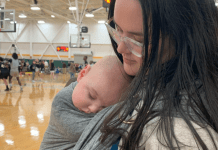Preeclampsia, which is diagnosed by the elevation of an expectant mother’s blood pressure after the 20th week of pregnancy, affects 5-8% of all pregnancies. There is increased research to cure this sometimes deadly condition. Visit the Preelampsia Foundation website for more info.
I had a pretty normal and boring pregnancy — until the very end. I did not have any morning sickness or other common pregnancy symptoms. The most I ever felt during my first trimester was fatigue, which is to be expected. Over the course of the first 28-30 weeks, I had normal weight gain, could exercise and generally lived a normal life — without Prosecco, of course!
 Toward the end, as pregnancy goes, my tummy started to increase in size and some of those uncomfortable pregnancy symptoms started to surface: peeing every five minutes, the inability to sleep comfortably in any position, round ligament pain, and some swelling in my feet. Again, all of this appeared to be all normal and I expressed any concerns I had to my doctors. The usual testing did not reveal anything, and my blood pressure was normal, so I looked at the increased swelling in my legs and feet with some trepidation, but I was not alarmed.
Toward the end, as pregnancy goes, my tummy started to increase in size and some of those uncomfortable pregnancy symptoms started to surface: peeing every five minutes, the inability to sleep comfortably in any position, round ligament pain, and some swelling in my feet. Again, all of this appeared to be all normal and I expressed any concerns I had to my doctors. The usual testing did not reveal anything, and my blood pressure was normal, so I looked at the increased swelling in my legs and feet with some trepidation, but I was not alarmed.
Preeclampsia Diagnosis While Already In Labor
The day before my water broke, I know now that I was having early labor symptoms in the form of vague contractions that would come and go. That night, I could barely sleep, and then my water broke at about 4:45 a.m., which felt like a swift kick to the gut.
Things got interesting from here – my contractions immediately went to about 3 to 5 minutes apart and we were quickly on the way to the hospital. When I got there and endured my first cervical check, I was already 4 cm dilated!
However, at this point I had vomited a couple times (I could not even drink water) and could not use the bathroom. Those are all huge red flags, along with elevated blood pressure and some markers in bloodwork, so I was officially diagnosed with preecamplsia while in labor!
 Unfortunately, I had to get a catheter to monitor my urine output, and a magnesium drip to treat the preeclampsia throughout my entire labor. This was not part of my plan. Anyway, I quickly progressed to 7 cm and then 9 cm but got stuck there. This was over the course of many, many hours.
Unfortunately, I had to get a catheter to monitor my urine output, and a magnesium drip to treat the preeclampsia throughout my entire labor. This was not part of my plan. Anyway, I quickly progressed to 7 cm and then 9 cm but got stuck there. This was over the course of many, many hours.
I had a blood pressure cuff on the entire time as well, which took readings every 20 minutes (if I remember correctly). There was also a monitor on my stomach for the baby.
My nurse (who was awesome and did not play cards for one minute), watched me extremely closely, and even helped me stick to my plan to not get an epidural, along with my doula.
After 20 hours of labor, my little guy was born and everything seemed to be on the up and up. My blood pressure went down immediately and my urine output went back to normal. However, this was short-lived.
Postpartum Spikes in Blood Pressure
I was stable for a whole day and I was scheduled to go home early, but my blood pressure started to spike. It went so high that I had to be treated with IV blood pressure meds, and there was some discussion that if anything else happened, I would have to be moved out of the postpartum unit (without my baby!) for treatment.
Because I had preeclampsia during labor, my blood pressure was taken every two hours – which is how doctors caught my postpartum spike – and after it spiked, it was taken every 30 minutes to an hour.
It was very clear that my hospital had a clear protocol with this and it was unlike the many horror stories I have read about since my own experience.

I ended up staying in the hospital until I was stable for a total of five nights. It was a long haul. If I had to stay any longer, my baby would have been discharged without me since he was in perfect health and I was taking up a room in postpartum care. The hospital did everything within its power to ensure this would not happen.
As someone who had never been admitted to the hospital for anything or even had a broken bone, this was an extremely scary experience. This was particularly true because I had no clear preeclampsia symptoms until I went into labor. No headaches, normal blood pressure, no protein my urine or anything else. The only clues are that I had increased swelling in my feet and legs, and gained about 55 pounds overall, but both can be completely normal!
Good News: My Blood Pressure Has Been Normal for Over Three Years
At discharge, I was prescribed a 30-day course of blood pressure meds and had to follow-up in the doctor’s office on a regular basis during my first month of recovery. I did not had any other postpartum scares and my blood pressure has been normal ever since.
After my experience I learned that I had a pretty “typical” case of preeclampsia and it is unlikely to recur in a second pregnancy. My condition was late onset at 39 weeks gestation, was easily controlled during labor and postpartum, and all symptoms went away within a month after delivery.
However, I did have a two risk factors: it was my first pregnancy and I’m African-American.
It is so important that women have access to prenatal and postpartum care. I’m 100% positive the excellent care I received saved my and my baby’s lives.
May is Preeclampsia Awareness Month. Find more info here.









![Lauren Engler: Mom of the Month [April 2024]](https://dcmoms.com/wp-content/uploads/2024/04/Lauren-Engler-218x150.png)






Thanks for sharing! That’s so scary. I’m glad that your hospital monitored you so closely and took your symptoms seriously!
GW was awesome. They were on top of it from start to finish! It put me at (some) ease in the moment.
WOW! Thank you for sharing your story. I had no idea that this could happen. I’m sorry you had a truly scary experience, but I’m so thrilled that everything turned out OK.
Thanks! 🙂
Comments are closed.